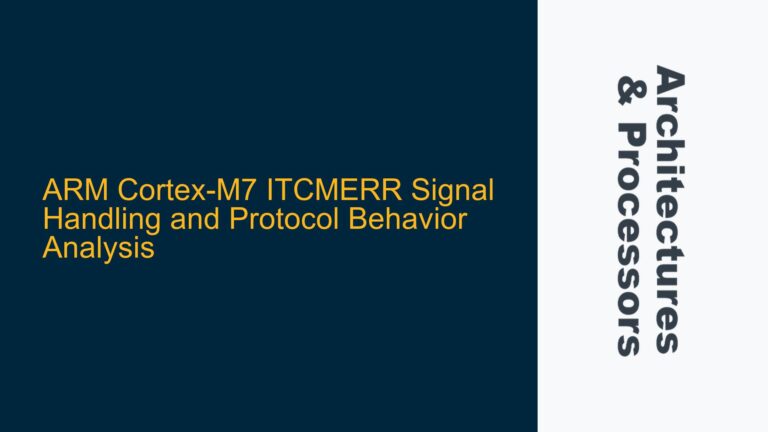ARM CPU Subsystem Design for Multi-Product Families
Designing an ARM-based CPU subsystem involves integrating ARM CPU cores, AXI/AHB bus interconnects, memory controllers, DMA controllers, and cache systems. One of the primary challenges is determining whether to create a single, highly configurable subsystem that can cater to multiple product families (such as Automotive, Consumer, and IoT) or to design a unique subsystem for each product. The decision impacts not only the design complexity but also the verification strategy, debug system implementation, and pre-silicon validation.
A single configurable subsystem offers the advantage of reusability across different product lines, reducing development time and cost. However, it introduces complexity in terms of configurability, verification coverage, and potential performance trade-offs. On the other hand, designing a dedicated subsystem for each product ensures optimal performance and simpler verification but increases development effort and time-to-market.
The ARM CPU subsystem must also address the integration of debug systems, especially in multicore environments. Debug systems are critical for pre-silicon verification and post-silicon validation, enabling engineers to trace and diagnose issues in real-time. The complexity of debug systems increases with the number of cores, interconnects, and peripherals, requiring a robust verification strategy to ensure correctness.
Configuration Overhead vs. Product-Specific Optimization Trade-offs
The decision to use a single configurable subsystem or multiple product-specific subsystems involves trade-offs between configurability, performance, and development effort. A single configurable subsystem requires extensive parameterization to support different product requirements, such as varying memory sizes, peripheral sets, and performance targets. This parameterization introduces additional complexity in the RTL design, synthesis constraints, and verification environment.
For example, a configurable subsystem might include parameters for the number of AXI masters, AHB slaves, cache sizes, and memory controller types. While this approach allows the same subsystem to be used across different products, it can lead to inefficiencies in resource utilization and performance. Additionally, the verification environment must account for all possible configurations, increasing the number of test cases and simulation cycles required.
In contrast, product-specific subsystems are tailored to the exact requirements of a particular product, eliminating unnecessary configurability and optimizing performance. However, this approach requires separate development efforts for each product, increasing the overall design and verification workload. It also limits the reuse of IP blocks and verification components, potentially leading to inconsistencies across products.
The choice between these approaches depends on the product portfolio, development timeline, and resource availability. For companies with a diverse product range and tight time-to-market constraints, a configurable subsystem might be more suitable. Conversely, companies focusing on a few high-performance products might benefit from product-specific subsystems.
Debug System Implementation and Pre-Silicon Verification for Multicore Subsystems
Debugging multicore ARM CPU subsystems is a significant challenge due to the complexity of interactions between cores, interconnects, and peripherals. The debug system must provide visibility into the internal state of each core, the bus transactions, and the memory subsystem. This requires the integration of debug interfaces, such as ARM CoreSight, and the development of a comprehensive verification strategy.
ARM CoreSight is a widely used debug and trace technology that provides real-time visibility into the operation of ARM-based systems. It includes components such as Debug Access Ports (DAPs), Embedded Trace Macrocell (ETM), and Trace Port Interface Units (TPIUs). These components enable engineers to trace program execution, monitor bus transactions, and diagnose issues in real-time.
The verification of the debug system involves ensuring that all CoreSight components are correctly integrated and that the trace data is accurately captured and analyzed. This requires the development of a verification environment that can simulate the operation of the debug system under various scenarios, including multicore synchronization, interrupt handling, and memory access conflicts.
Pre-silicon verification is particularly challenging for multicore subsystems due to the complexity of interactions between cores and the potential for race conditions and deadlocks. The verification environment must include scenarios that stress-test the subsystem, such as simultaneous access to shared resources, cache coherency issues, and power domain transitions. This requires a combination of directed tests and constrained random verification to ensure comprehensive coverage.
In addition to functional verification, the debug system must also be validated for performance and power consumption. This involves analyzing the impact of debug operations on system performance and ensuring that the debug system does not introduce significant overhead. Power-aware verification techniques, such as power-aware simulation and emulation, are used to validate the power management features of the subsystem.
Implementing a Robust Verification Strategy for ARM CPU Subsystems
A robust verification strategy for ARM CPU subsystems involves a combination of simulation, emulation, and formal verification techniques. The verification environment must be designed to handle the complexity of the subsystem, including the interactions between cores, interconnects, and peripherals. This requires a systematic approach to test case generation, coverage analysis, and debugging.
Simulation is the primary method for pre-silicon verification, allowing engineers to test the subsystem in a controlled environment. The simulation environment must include models for all components of the subsystem, including the ARM CPU cores, AXI/AHB interconnects, memory controllers, and peripherals. The environment must also support the generation of realistic test scenarios, such as multicore synchronization, cache coherency, and interrupt handling.
Emulation is used to accelerate the verification process by running the subsystem on hardware emulators. This allows engineers to test the subsystem at near-real-time speeds, enabling the validation of complex scenarios that are difficult to simulate. Emulation is particularly useful for validating the performance and power consumption of the subsystem, as well as for debugging complex issues that are difficult to reproduce in simulation.
Formal verification is used to prove the correctness of critical components of the subsystem, such as the bus interconnects and cache coherency logic. Formal verification involves the use of mathematical techniques to prove that the design meets its specifications, providing a higher level of confidence in the correctness of the design. This is particularly important for components that are difficult to verify using simulation alone, such as complex state machines and protocol checkers.
Coverage analysis is a critical part of the verification strategy, ensuring that all aspects of the subsystem have been tested. This includes functional coverage, which measures the extent to which the test cases have exercised the functionality of the subsystem, and code coverage, which measures the extent to which the RTL code has been executed. Coverage analysis helps identify gaps in the verification process and guides the development of additional test cases to ensure comprehensive coverage.
Debugging is an integral part of the verification process, allowing engineers to diagnose and fix issues in the subsystem. The debug system must provide visibility into the internal state of the subsystem, including the state of the cores, interconnects, and peripherals. This requires the integration of debug interfaces, such as ARM CoreSight, and the development of tools for analyzing trace data and diagnosing issues.
Conclusion
Designing and verifying an ARM CPU subsystem is a complex task that requires a systematic approach to configuration, debug system implementation, and verification. The choice between a single configurable subsystem and multiple product-specific subsystems involves trade-offs between configurability, performance, and development effort. The debug system must provide comprehensive visibility into the operation of the subsystem, enabling engineers to diagnose and fix issues in real-time. A robust verification strategy, combining simulation, emulation, and formal verification, is essential for ensuring the correctness and performance of the subsystem. By addressing these challenges, engineers can develop ARM CPU subsystems that meet the requirements of a wide range of products, from automotive to consumer and IoT applications.






